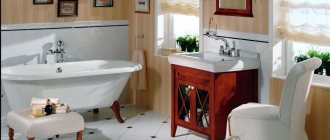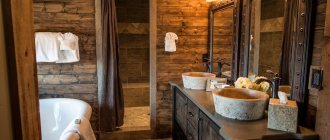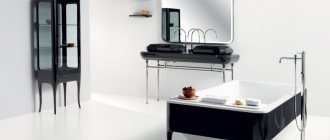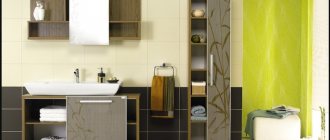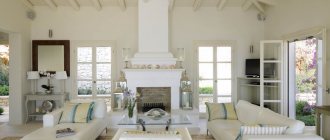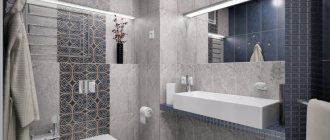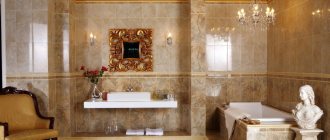Retrostyle is a trend in interior design that was relevant in the 60-70s of the last century. When choosing retro-style bathroom furniture, you need to remember that it is interesting, varied, but quite complex. All elements of this room must be selected flawlessly. Even a minor inaccuracy can easily disrupt the harmony of the plan.
Retro-style bathroom includes antique finishes and vintage furniture
Sink on a narrow leg
Now, in the era of wall-hung sanitary ware with futuristic shapes, a deep round sink on a narrow pedestal looks very vintage. Together with simple curtains, a massive mirror in a slightly worn wooden frame, a wrought-iron chandelier and wicker baskets, it creates the retro style that many people strive for in their bathroom.
Photo:
Characteristics of vintage style
- Vintage allows you to use antique and modern items;
- Everything is very simple, no luxury;
- Vintage suggests the effect of slight disorder in the bathroom;
- Nothing bright or provocative in the decoration.
It should be noted that creating a bathroom in a vintage style requires a lot of time and money. It's not so easy to find the right design or decor element. Not everything can be purchased or made with your own hands.
Textile dissonance
Bathroom interiors of past decades were often united by such details as textile eclecticism. It seems that everything in the interior in the photo is mixed: terry towels, a striped curtain with frills, a window curtain with an abstract black and white pattern, a voluminous rug.
Photo:
Rethinking
Worn-out items like a homemade garden ladder or an antique table with rusty legs feel great in a retro-style bathroom interior. The main thing is to come up with a use for them. In this interior, for example, the staircase is used as a towel rack.
Photo:
Features Retro
Retro style bathroom
Many people believe that a retro-style bathtub is the same classic style, which has some features and is its logical continuation. In fact, this is a mistaken opinion, since the retro trend appeared long before the standard classics, although at first glance it has a lot in common. The distinctive characteristics of the style are:
- the presence of furniture from the 50s or 70s;
- handmade knitted rugs;
- a retro bathroom should have a cast iron or steel bathtub;
- the presence of wooden or plastic shelves;
- lack of a shower with a flexible hose;
- mirrors with wooden frame.
When decorating a room, it is important to remember that a retro-style bathroom does not accept the use of modern materials such as acrylic. It is also worth considering that this style does not impose any requirements on the size of the space and can be used in rooms of different sizes.
When choosing this style, an antique bathroom should naturally have old or artificially aged interior elements, but you shouldn’t overuse this too much, since the room will turn into a museum or antique utensils store. Designers consider special features of the style to be the presence of a rough rug knitted from natural wool or wall lamps with characteristic blown lampshades, without which not a single retro bathroom could do.
Retro style plumbing
Retro style plumbing elements
The most important role in this style is played by plumbing, since it is the variant of its execution that brings distinctive features. All elements, from the faucet to the bathtub, must be made of metal, since retro in the bathroom does not accept any modern materials. A bathroom, which is considered the highlight of the style, should have a standard appearance with rounded shapes and the obligatory presence of small legs. Embedding a bowl into the floor is strictly prohibited.
Retro bathroom design involves a ceramic washbasin in the usual bowl shape. Such products easily fit into massive furniture or can be hung on decorative brackets. Even if your retro-style bathroom uses modern plumbing options, they need to be decorated with slightly worn metal or cast iron to best match the direction.
An important point is the shower, which, according to design requirements, cannot have a flexible hose and is built into the wall.
Furniture and accessories
Retro style furniture
There are still ongoing debates about the time period to which this style can be attributed and the types of accessories used in the interior. Retro bathroom furniture is often criticized and classified as vintage. At the same time, almost all world-class designers are inclined to believe that small decorative elements are transitional and can be used in both cases. One thing is clear: the interior of a retro-style bathroom must have elements with forced aging, which is the hallmark of the style.
Bathroom in minimalist style. Interior elements and furniture selection
For example, a large mirror with a wooden frame that shows signs of years of scratches and cracking paint is a must. Lighting fixtures are equipped with shades with frosted glass, which will not give glare and will highlight properly designed retro bathroom furniture. The ceiling chandelier can be suspended on small chains, and rare jugs made of ceramics or earthenware are installed in niches and on shelves.
If the design of the room does not give a complete feeling of the desired style due to the use of controversial elements, then the best solution to emphasize the retro direction would be bathroom furniture with patina. The vintage patina effect is not used.
Vintage tiles
You can give your bathroom a retro effect using time-tested ceramic tile combinations. If you decorate the bathroom walls with classic hog tiles and decorate the floor with small ceramic hexagons, you can create a retro style. Pay attention to the flower patterns laid out with black tiles - this used to be one of the main trends!
Photo:
Mixer
The main requirement for a retro bathtub faucet is that it must be in harmony with it in style. Therefore, you need to forget about massive, chrome-plated faucets with a long spout. Our choice is miniature drop-shaped faucets with valve control. The color of the mixer should match the decorative elements on the font itself (for example, with support legs). Preference should be given to models coated with aged metal, such as copper or brass. Shower heads should be of a classic design: they are shaped like old telephone receivers.
Retro style with a modern twist
It is not necessary to use aged elements in the interior: create a retro style with a modern interpretation. In our case, this was achieved with the help of classic accents in the form of decorative columns by the window, a pedestal bathtub, a vintage chair and stucco moldings on the walls.
Photo:
Aged elements
Luckily, vintage style isn't just about bows, lace and flowers. These include aged decorative elements, which have a more austere character and a more restrained style. There are a lot of options - aged tiles, worn wood, worn metal elements. Everything can emphasize the effect of antiquity and remind us of the long history of materials.
It is important that today it is not necessary to artificially age wood or wipe down metal to bring a vintage effect to a space. You can use high quality modern ceramic tiles. For bathroom decor, manufacturers offer a lot of different options, including the effects of worn wood of different types of wood, elements with worn inscriptions, old metal, worn and cracked tiles. At the same time, the quality of the finish will remain at a very high level, and all abrasions and chips, cracks and irregularities will only add a special charm to the interior design, but in no case will this affect the service life of the elements.
Vivid details
Here the retro effect was achieved only through accessories: green curtains with a floral pattern, an antique wall lamp, soft yellow towels, a shelf with an antique edge and worn bamboo roller blinds did the trick.
Photo:
Vintage chic
The key accent of this bathroom lies in the color scheme: the combination of pale turquoise and white looks very vintage. A matching washbasin cabinet in a classic style only enhances the effect.
Photo:
Antique style bath
A separately placed bathtub complete with a shower set will look very good. If we talk about color shades, then old bronze or tarnished copper are ideal in this case. A bathroom in this style will not only look great, but you will also find it quite comfortable if you choose the right curtains. This way you will be able to avoid unwanted splashes on the furniture, because all the interior details of a retro bathtub should be made of natural material.
The choice of clawfoot bathtubs is quite wide, but before you give your preference to one of them, you should decide what color scheme you want to see in your interior as a whole. An old-style shower set, sanitary ware, faucet and washbasin look much more harmonious in one shade. As a rule, parts such as towel rails, shelves and various stands are sold as a set.
Tile with dramatic patterns
Another bathroom in which the desired retro effect was achieved through black and white tiles. This time it's not about geometry, but about patterns. The patterns on the rug, walls, floor and even the textile chair cover look excessive, although they work well together, and the green accents soften the effect.
Photo:
Room color scheme
Retro style is dominated by soft, muted tones, but it should not be exclusively brown-gray-beige colors (after all, artificial dyes had already been invented by that time). However, bright, saturated colors are rarely found in wall or floor decoration. As a rule, light colors are used for this - white, milky, beige, coffee, light lemon. The combination of light walls and dark floors, for example the contrast of white and black, is also popular.
Furniture and accessories are used as bright spots of color in retro style. Mahogany-colored cabinets, turquoise poufs or yellow lamps bring liveliness to a restrained interior.
Plumbing comes to the fore again
A prime example of how to create a retro-style interior using an antique claw-foot sink and taps with a vintage silhouette. Notice the color of the wall - again pale turquoise.
Photo:
Mirror in a luxurious frame
And don’t forget about one of the main attributes of the bathroom - we are talking about the mirror. It, like all other objects, performs both functional and aesthetic tasks. Therefore, it must be dressed in an impressive, beautiful frame: carved, elegant, wooden or gilded.
Photo: choisirsabaignoire.com
For a vintage bathroom, you can choose an old large mirror if space allows. A mirror with beautiful legs for placing on the floor is also suitable.
Old metal table
Look how this table transformed the bathroom: in places where the orange paint has peeled off, you can see that it has clearly survived more than one painting. A wooden box under the tabletop continues the theme of aged elements in the interior.
Photo:
Antique bathroom fixtures
Choosing the right plumbing equipment for such an interior is not easy. Standard versions of bathtubs, toilets, faucets with shiny chrome and stainless steel are not suitable for it. Antique design implies grandeur, chic, and some pretentiousness. It should have elements of Victorian, Baroque, Rococo style.
The bathtub in such an interior is not installed near the wall: it is mounted in an open space. An ideal option would be a structure made of brass. But if this elite option is not available, you can opt for a cast iron, steel model in white or “marbled” with smooth or curved shapes. It is great if the support of the structure is legs in the shape of “lion paws” or decorated with elements in plant motifs. The basis can be an elegant cabinet: such a solution will look quite unusual, fitting into the overall concept.
The sink should blend harmoniously with the bathroom. Decor similar to that which complements the legs can be placed on an elegant cabinet supporting the bowl. There is no need to place cabinets or shelves for accessories next to the sink. It, like the bathtub, should be open.
Choosing a toilet for an antique interior can create difficulties. Models equipped with a mounted tank fit harmoniously into such designs. If you don’t find one, you can choose a toilet with a lid decorated with carvings.
Stained glass
If you're planning a retro-style bathroom in a private home, consider stained glass windows with floral patterns and vintage geometries instead of regular glass.
Photo:

